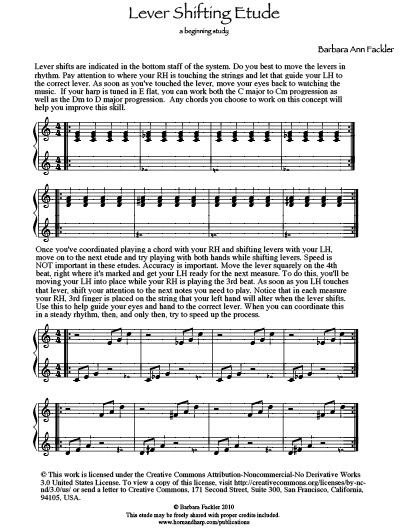
Learning to shift levers can be a challenge but once you learn some basic tricks, it becomes second nature. The first thing you need to do is evaluate the task. With time, those of you who go on to read lead sheets will be able to sight read and grab lever shifts (changes) more quickly.
Remember that you don't need to watch your hand move the lever. Think of what you do when you drop your fork at the dinner table. What most people do is look to see where it landed. Then, they reach to pick it up, no longer looking at the fork. Because they've seen where it is, their hand is able to go right to the fork. You can learn to do the same thing with levers. Learn to look away from the lever before you move it. You may need to see the lever at first, but eventually, you'll be able to find the levers without your eyes. The first step is to look away before you actually move the lever to its new position.
In the same way that you learned how to play your harp without watching your hands all the time, you need to get comfortable with moving your eyes away from the lever as soon as you've located it. There's a lot of choreography for the eyes in harp playing. Sometimes you need to watch your hands, sometimes you need to watch the music and sometimes you need to watch the levers. If you play in an ensemble, you'll need to watch your conductor or other ensemble members. When you think about shifting levers, it's important to remember that once you've put your hand where it needs to be, you no longer need your eyes on that task.
Practice moving a lever, any lever, quickly. Place your LH on the lever and learn to move your eyes away from the lever before you move the lever. This will help you prepare to keep your eyes moving in the context of a piece of music. Try playing a D minor chord and change the F natural to F sharp, which makes the chord D major. Shifting levers in rhythm is a good practice. Working in 4/4, play four beats of your first chord, then change the middle note of the chord to change the chord quality for the next four beats. Work through this until you can practically find that lever without your eyes. Here is a quick etude you can print to guide you through this process.
When you are confident that you can find the lever you want and move it efficiently, try the tutorial below, which uses Aura Lee (the inspiration for Elvis Presley's Love Me Tender). If you are at all inclined to learn to read changes, I recommend using the E flat tuning. There are a few more lever shifts, but the thought process will serve you well.
C tuning tutorial (PDF)
E flat tuning tutorial (PDF) This is the preferred version of this tutorial. Unless you tune in C or do not have full levers on your harp, use this version.
Listen to the arrangement of Aura Lee that is used in this tutorial: mp3 of the midi file
Coming soon, a collection of solos to help you increase your lever shifting skills. Instead of working on etudes you'll never perform, this collection of solo music will help you increase your lever skills while building your repertoire. There will be a longer version of Aura Lee included in this set.
Aura Lee is included in the lead collection, Songs of America (found in publications). It can be played with no lever changes if you leave out all the altered notes, which are never in the melody.
ADDED May 2025: M-O-T-H-E-R ~ Use the lead sheet for this title, found in this fantastic FREE collection: https://imslp.org/wiki/The_Public_Domain_Song_Anthology_(Berger,_David). I play this ONLY from the lead sheet, but for those of you just learning, I've come up with a brief description of how I made it work for lever harp. In music this chromatic, my prefernce is to move the levers in a way similar to how I'd move pedals, so notating this many lever shifts proved difficult. I eventually opted for notating them in the bass clef (lots of ledger lines) to allow for placement on the exact instant when the shift would ocurr.
Many thanks to harpists Chicago harpist Joanne Glover, North Carolina harpist Karin Lyle, West Coast harpist Alishia Joubert, Chicago artist Marcia Babler, Karen Perry, and harpist composer Janet Lanier for their help in editing this project.

The Lever Shift Tutorial by Barbara Ann Fackler are licensed under a Creative Commons Attribution-Noncommercial-No Derivative Works 3.0 United States License.